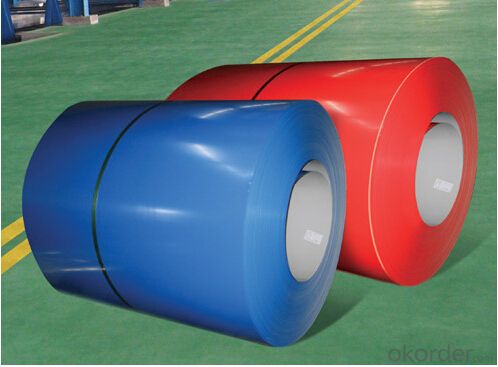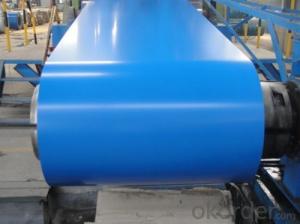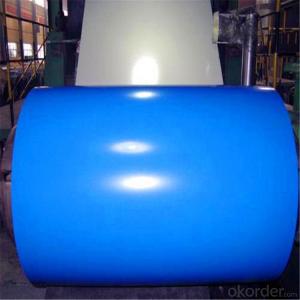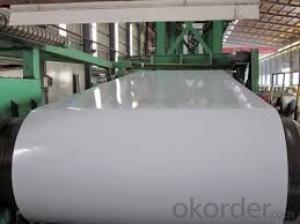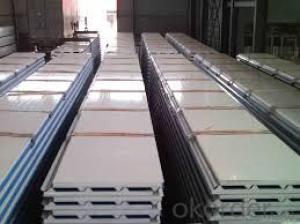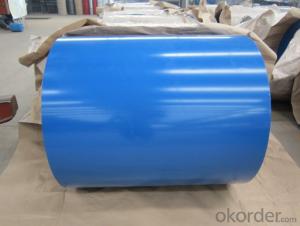High Quality of Prepainted Galvanized Steel Coil in China
- Loading Port:
- Tianjin
- Payment Terms:
- TT OR LC
- Min Order Qty:
- 50 m.t
- Supply Capability:
- 10000 m.t/month
OKorder Service Pledge
OKorder Financial Service
You Might Also Like
1. Pre-Painted Galvanized/Aluzinc Steel Coil Description:
With GI as base material, after pretreatment (degrease and chemical treatment ) and liquid dope with several layers of color, then after firing and cooling, finally the plate steel is called pre-painted galvanized (aluzinc) steel. Pre-painted galvanized steel is good capable of decoration, molding, corrosion resistance. It generally displays superior workability, durability and weather resistance.
2.Main Features of the Pre-Painted Galvanized/Aluzinc Steel Coil:
• Excellent process capability
• Smooth and flat surface
• Workability, durability
• Excellent heat resistance performance
• High strength
• Good formability
• Good visual effect
3.Pre-Painted Galvanized/Aluzinc Steel Coil Images

4.Pre-Painted Galvanized/Aluzinc Steel Coil Specification
Standard: AISI, ASTM, BS, DIN, GB, JIS
Grade: DX51D, DX52D
Thickness: 0.17-2.0mm
Brand Name: KMRLON
Model Number: coil
Type: Steel Coil
Technique: Cold Rolled
Surface Treatment: Coated
Application: Boiler Plate
Special Use: High-strength Steel Plate
Width: 20-1250mm
Length: customized
commoidty: pre-painted galvanized steel coil
Thickness: 0.13-4.0mm
width: 20-1250mm
zinc coating: 40-180g/m2
printing thickness: top side: 20+/-5 microns, back side: 5-7 microns
color: all RAL color
surface treatment: color coated
coil weight: 4-7 tons
coil ID: 508/610mm
packaging: standard seaworthy packing
5.FAQ of Pre-Painted Galvanized/Aluzinc Steel Coil
What’s the application of this product?
Roof, roof structure, surface sheet of balcony, frame of window, etc.
What’s the brand of the paint?
We use the best brand of all of the word—AKZO.
- Q: What are the typical tolerances for steel coils?
- The typical tolerances for steel coils depend on various factors such as the specific grade of steel, the manufacturing process, and the intended application. However, some common tolerances for steel coils include thickness tolerances of +/- 0.005 to 0.010 inches, width tolerances of +/- 0.020 to 0.050 inches, and length tolerances of +/- 0.125 to 0.250 inches. These tolerances ensure that the steel coils meet the required specifications and can be used efficiently in different industries such as automotive, construction, and manufacturing.
- Q: Nickel is ferro magnetic in nature. But when it is added with stainless steel, it makes stainless steel non-magnetic. What is the structural changes happened with the presence of nickel?
- Steel is magnetic because of the alignment of the spin in the electrons of the atoms in the crystaline matrix of the steel. Nickel atoms are not the same size as Iron atoms and Chromium atoms. by having several different sizes of atoms in the alloy, it prevents a uniform crystaline matrix from being formed. If you imagine a box of marbles that are all the same size, they will all settle into a regular pattern in the box. But a bunch of mismatched marbles will be jumbled together in irregular patterns. This prevents the magnetic properties of either element from asserting itself.
- Q: Hello,is it possible to divide an alloy in its own elements? I am particularly interested in Stainless Steel, which is made of Nickel, Chrome and Iron. Do you have an idea of where can I find some more information (blogs, reviews, sites or books)?Thanks for your help
- The iron ,nickel and chromium are (mainly) in solid solution with one another -- all the atoms are completely intermixed on the (FCC)crystal lattice . If you heat stainless steel until it melts , you will simply have a liquid solution of all the components --the components do not separate out. The only practical way to separate the metallic elements would be to make use of their differing reactivities -- re their oxides , nitrides , carbides etc -- and then gradually refine their compounds .
- Q: How are steel coils coated?
- Steel coils are typically coated through a process known as coil coating, which involves applying a protective layer to the surface of the steel. This is done by passing the coil through a series of rollers that apply the coating material evenly across the entire surface. The coating can be applied using various methods such as roll coating, spray coating, or electrostatic coating, depending on the desired finish and properties. The coated steel coils are then cured or baked to ensure the coating adheres properly and provides the desired level of protection and durability.
- Q: What are the different grades of steel used in manufacturing steel coils?
- The different grades of steel used in manufacturing steel coils include low carbon steel, medium carbon steel, high carbon steel, and stainless steel.
- Q: They are showing on tv a special on how the new World Trade Center, building 1, is being built. Focusing on the steel and the guys fitting everything together.Where do builders go to buy all that steel framing? We do not build really tall buildings where I live so most of the steel is cut and welded on the job site. At World Trade Center 1, they seem to get the steel on trucks; already cut and welded.
- Most of the parts are cut, welded, and fabricated indoors in a welding shop at another location. Then they're trucked to the site and simply need to be bolted together. This is made possible through the use of computer aided design and modeling programs, so that parts can be made to fit almost presciently in the field. They buy the steel from steel companies. I couldn't tell you exactly where it comes from, you'd have to ask the contractors themselves.
- Q: What are the dimensions of steel coils used in the transportation equipment industry?
- The dimensions of steel coils used in the transportation equipment industry can vary depending on the specific requirements and applications. However, there are some common dimensions that are widely used. The width of steel coils used in the transportation equipment industry typically ranges from 600mm to 2000mm (24 to 78 inches). This width is chosen to ensure compatibility with the machinery and equipment used for transportation, such as trucks, trailers, and railcars. The thickness of steel coils can vary greatly depending on the specific application and the desired strength of the material. However, common thickness ranges for transportation equipment industry steel coils are typically between 0.5mm and 6mm (0.02 to 0.24 inches). The inner diameter of steel coils used in the transportation equipment industry is typically standardized at either 508mm (20 inches) or 610mm (24 inches). This standardization allows for easy handling and compatibility with the machinery used in the industry. The outer diameter of steel coils can vary depending on the width and thickness of the coil. However, common outer diameter ranges for transportation equipment industry steel coils are typically between 1000mm and 2200mm (39 to 87 inches). It is important to note that these dimensions are not fixed and can be customized based on specific requirements and applications within the transportation equipment industry.
- Q: What are the different types of steel coil cutting tools?
- There are several types of steel coil cutting tools, including slitting shears, rotary slitters, flying shears, and laser cutters. Each tool is designed to cut steel coils into specific shapes and dimensions, depending on the desired end product.
- Q: How are steel coils used in the manufacturing of wires?
- Steel coils are used in the manufacturing of wires by being fed into wire drawing machines, where they are gradually reduced in diameter through a series of dies. The steel coils serve as the initial raw material, providing the necessary strength and flexibility for the wires to be produced.
- Q: a steel abr sells for about 879 now...a mith just over 1kany suggestions on which-keyword WHICH steel item to make-which is the best-exp wise, and steel bar conservative wise.
- If members, cannonballs. If not, steel kites, I suppose. Steel Platebody only alchs for 1200, and requires 5 bars... But I stuck with steel, till 70 smithing... cheaper, and requires less coal to make....
Send your message to us
High Quality of Prepainted Galvanized Steel Coil in China
- Loading Port:
- Tianjin
- Payment Terms:
- TT OR LC
- Min Order Qty:
- 50 m.t
- Supply Capability:
- 10000 m.t/month
OKorder Service Pledge
OKorder Financial Service
Similar products
Hot products
Hot Searches
Related keywords





